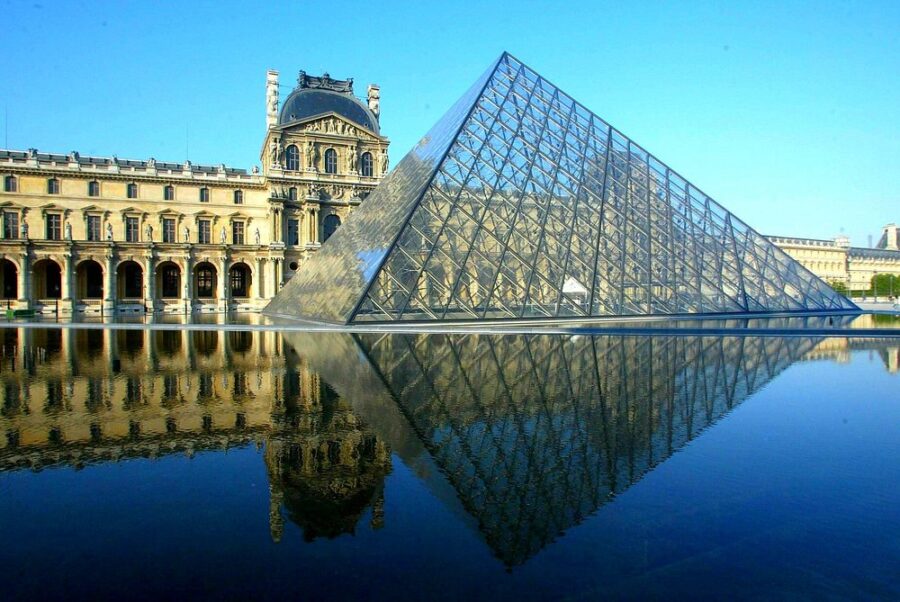
Louvre Pyramid
Table of Contents
- History and Significance
- Main Attractions and Activities
- The Pyramid Itself
- Underground Lobby
- Photo Ops Galore
- Special Exhibits Access
- Visitor Experience
- Tips for Visitors
- Accessibility and Facilities
- Unique Features
- Overall Impressions
- Pros and Cons
- Pros:
- Cons:
- Should You Visit?
- Location
- Places to Stay Near Louvre Pyramid
- Find and Book a Tour
- Explore More Travel Guides
History and Significance

Let’s shatter a myth first: the Louvre Pyramid isn’t some ancient relic hauled from Egypt. It’s younger than Star Wars—built in 1989 amid gasps from Parisians who thought architect I.M. Pei had lost his mind. A glass-and-steel spaceship landing in the courtyard of a 16th-century palace? Sacré bleu!
But here’s the twist: that “modern monstrosity” is now as iconic as the Mona Lisa’s smirk. The pyramid solved a practical problem—the Louvre needed a grand entrance that could handle 10 million visitors a year without ruining its historic facades. Pei’s design? A 21-meter-tall geometric marvel with 673 glass panes (666, if you believe the Da Vinci Code conspiracy theories).
Fun fact: The glass is self-cleaning. Because even pyramids deserve to look sharp in the Parisian drizzle.
Main Attractions and Activities
The Pyramid Itself
By day, it’s a kaleidoscope of light, refracting sunbeams onto the Cour Napoléon. By night? A glowing beacon—best viewed from the Arc de Triomphe du Carrousel with a crêpe in hand.
Underground Lobby
The pyramid’s real magic lies beneath. Descend into the Hall Napoléon, a vast subterranean hub where:
-
Ticket lines snake (pro tip: buy online)
-
The inverted pyramid drips mystery (Dan Brown fans, this is your moment)
-
Three wings diverge like a museum choose-your-own-adventure
Photo Ops Galore
-
The “Holding the Pyramid” shot: Squat near the central fountain, pinch the apex between thumb and forefinger. Basic? Yes. Mandatory? Also yes.
-
Reflection hunting: After rain, the wet cobblestones mirror the glass perfectly.
Special Exhibits Access
Temporary shows (like last year’s “Venus de Milo: Color Rediscovered”) often use the pyramid entrance. Early birds get quieter viewing.
Visitor Experience
Here’s the truth: the pyramid is both breathtaking and a bottleneck. At noon, it’s a mosh pit of selfie sticks and school groups. Visit at 9 AM or after 6 PM (Wednesday/Friday late openings) to actually appreciate its geometry without elbowing through crowds.
The glass creates a greenhouse effect—balmy in winter, sweltering in summer. Dress in layers unless you enjoy sweating like a courtier at Versailles.
And about those 673 panes? Spotless. Rumor says a team of robot cleaners scales it nightly. (Reality: brave humans with squeegees on ropes.)
Tips for Visitors
-
Skip-the-line tickets: Book at www.louvre.fr for €17. The on-site queue? A soul-crushing 2+ hours.
-
Free entry: First Saturday of each month, 6-9:45 PM (prepare for crowds).
-
Metro: Palais Royal-Musée du Louvre (Line 1) drops you under the pyramid.
-
Baggage: Large backpacks = forced check-in. Pack light.
-
Combined tickets: The Musée Delacroix (€3 extra) is a 10-minute walk and blissfully quiet.
Accessibility and Facilities
-
Wheelchair access: Ramps and elevators everywhere. Loaner chairs are available.
-
Cloakroom: Free (but often full by 11 AM).
-
Toilets: Underground, surprisingly chic. Peak hours = lines.
-
Food: The Café Marly offers pyramid views at extortionate prices. Better to picnic in the Tuileries.
Unique Features
Why does this pyramid outshine others?
-
The Illusion: From certain angles, it appears to float. (Pei’s engineering sorcery.)
-
The Controversy: Parisians hated it initially. Now they defend it fiercely.
-
The Night View: Lit from within, it becomes a ghostly lantern—best seen from Rue de Rivoli.
Overall Impressions
The Louvre Pyramid is a dichotomy:
-
A futuristic intrusion that somehow enhances the Renaissance palace
-
A practical entrance that became the museum’s most photographed artifact
-
A symbol of change in a city that resists it
Standing beneath its glass grid, you’re literally inside a work of art while surrounded by millennia of others. Meta? Absolutely.
Pros and Cons
Pros:
- Iconic architecture (your Instagram needs this)
- Stunning light plays (sunrise = magic hour)
- Efficient crowd flow (when not at peak times)
Cons:
- Midday crowds rival Versailles’ Hall of Mirrors
- Glass glare can hinder photos
- No seating nearby (blame security concerns)
Should You Visit?
Oui, but strategically. The pyramid isn’t just a doorway—it’s a statement about art’s evolution. Come for:
-
Golden hour photography (6-8 PM in summer)
-
The thrill of standing where history clashes with modernity
-
Bragging rights (because who hasn’t pseudo-held this pyramid?)
Just don’t expect solitude. As Pei himself said: “The Louvre is a mirror—it reflects Paris.” And Paris? She’s always watching.
Location
Places to Stay Near Louvre Pyramid
Find and Book a Tour
Explore More Travel Guides
No reviews found! Be the first to review!